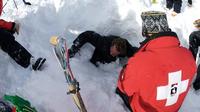-
Biometric security for mobile devices becoming mainstream
Biometric security such as fingerprint, face, and voice recognition is set to hit the mainstream as global technology companies market the systems as convenient and easy to use. The latest biometric technologies are not without their security issues, but they are marketed as more convenient than traditional methods rather than more secure, and encourage adoption by people who currently do not have any security on their phone at all.
-
-
Platform for operating systems would outwit cyber criminals
As smartphone use surges, consumers are just beginning to realize their devices are not quite as secure as they thought. A Swedish research team is working on a way to secure mobile operating systems so that consumers can be confident that their data is protected.
-
-
App helps save people trapped by avalanche

For the person buried under the weight of an avalanche, each minute is precious. A person saved from the snow mass within fifteen minutes has a 90 percent chance of survival. After forty-five minutes that chance has diminished considerably. Researchers develop an app that makes it possible for skiers with smartphones to find people buried in the snow.
-
-
Virtual lab for nuclear waste repository research
A nuclear waste repository must seal in radioactive waste safely for one million years. Researchers currently have to study repositories and their processes in real underground laboratories, but a virtual underground laboratory will soon simplify their work.
-
-
Unsupervised robotic construction crew to build flood defenses
On the plains of Namibia, millions of tiny termites are building a mound of soil — an 8-foot-tall “lung” for their underground nest. They do so without a supervisor, foreman, or CEO to tell them what to do. During a year of construction, many termites will live and die, wind and rain will erode the structure, and yet the colony’s life-sustaining project will continue. Harvard researchers, inspired by the termites’ resilience and collective intelligence, have created an autonomous robotic construction crew. The system needs no supervisor, no eye in the sky, and no communication: just simple robots — any number of robots — that cooperate by modifying their environment. In the future, similar robots could lay sandbags in advance of a flood, or perform simple construction tasks on Mars.
-
-
Remote explosives detection may see the end of full-body scanners
Standing in a full-body scanner at an airport is not fun, and the process adds time and stress to a journey. It also raises privacy concerns. Researchers now report a more precise and direct method for using terahertz (THz) technology to detect explosives from greater distances. The advance could ultimately lead to detectors that survey a wider area of an airport without the need for full-body scanners.
-
-
Advancing algae’s viability as a biofuel
Lab success does not always translate to real-world success. A team of scientists, however, has invented a new technology that increases the odds of helping algae-based biofuels cross that gap and come closer to reality. The current issue of Algal Research showcases the team’s invention — the environmental photobioreactor. The ePBR system is the world’s first standard algae growing platform, one that simulates dynamic natural environments.
-
-
Countering counterfeit electronic components
Used and non-authentic counterfeit electronic components are widespread throughout the defense supply chain; over the past two years alone, more than one million suspect parts have been associated with known supply chain compromises. In the military, a malfunction of a single part could lead to system failures that can put soldier lives and missions at risk. A new DARPA program seeks tool that authenticates electronic components at any step of the supply chain.
-
-
Sandia Lab leading multidisciplinary effort to counter WMD
Threats of terrorism and weapons of mass destruction do not seem as imminent today as they did after the 9/11 attacks, but Jill Hruby, vice president of International, Homeland, and Nuclear Security at Sandia Labs, says that scientists, industry, and universities working on technological solutions to national security challenges must anticipate what could come next. Speaking at AAAS annual meeting, Hruby said that in an environment of lower public interest — due, in part, to the success of early efforts to combat terrorism that resulted in fewer major incidents in recent years — continued collaboration between national security laboratories, academia, and industry is needed.
-
-
Sensors would spot structural weaknesses in bridges, stadiums before they collapse
A team of engineers, with a grant of $1 million from the government of Qatar, will work to develop a wireless sensor network which will monitor vibrations, sagging, and stresses to assess a structure’s ability to carry its load. The proposed system would not only detect damage after it occurs, but would aim to predict it before it takes place.
-
-
New technologies make police work more effective
Law enforcement officers across the country are adapting to new technologies which aim to improve efficiency and accuracy on the job. The average police car is now equipped with a laptop which provides access to national criminal databases, portable fingerprint scanners, Breathalyzer units, automatic license-plate-readers, and even printers that can print out a citation ticket. Experts stress that while technology has equipped law enforcement officers with sophisticated resources, officers must not abandon old-fashioned practices like maintaining a personal connection with the communities they serve.
-
-
Micro-windmills to recharge cell phones, used for home energy generation
Researchers have designed a micro-windmill that generates wind energy and may become an innovative solution to cell phone batteries constantly in need of recharging, and home energy generation where large windmills are not preferred. The device is about 1.8 mm at its widest point. A single grain of rice could hold about ten of these tiny windmills. Hundreds of the windmills could be embedded in a sleeve for a cell phone.
-
-
Tracking spilled oil
A newly developed computer model holds the promise of helping scientists track and predict where oil will go after a spill, sometimes years later. Scientists developed the model as a way of tracking the movement of sand and oil found along the Gulf of Mexico since the Deepwater Horizon oil spill. The new tool can help guide clean-up efforts, and be used to aid the response to future oil spills.
-
-
Online 3D immersive learning environments to boost kids’ science skills
For the first time, a new online 3D educational world which replicates real life environments is set to improve the science skills of students. Using their avatar, students will embark on a journey from their own research lab through and “immersive learning” environments which will mirror real-life places. As they progress through quests, they will explore the surrounding environment and complete inquiry based learning tasks which test their core science skills and gain rewards.
-
-
New software obfuscation system a cryptography game changer

A team of researchers has designed a system to encrypt software so that it only allows someone to use a program as intended while preventing any deciphering of the code behind it. This is known in computer science as “software obfuscation,” and it is the first time it has been accomplished. Previously developed techniques for obfuscation presented only a “speed bump,” forcing an attacker to spend some effort, perhaps a few days, trying to reverse-engineer the software. The new system puts up an “iron wall,” making it impossible for an adversary to reverse-engineer the software without solving mathematical problems that take hundreds of years to work out on today’s computers — a game-change in the field of cryptography.
-
More headlines
The long view
Encryption Breakthrough Lays Groundwork for Privacy-Preserving AI Models
In an era where data privacy concerns loom large, a new approach in artificial intelligence (AI) could reshape how sensitive information is processed. New AI framework enables secure neural network computation without sacrificing accuracy.
AI-Controlled Fighter Jets May Be Closer Than We Think — and Would Change the Face of Warfare
By Arun Dawson
Could we be on the verge of an era where fighter jets take flight without pilots – and are controlled by artificial intelligence (AI)? US R Adm Michael Donnelly recently said that an upcoming combat jet could be the navy’s last one with a pilot in the cockpit.
AI and the Future of the U.S. Electric Grid
By Doug Irving
Despite its age, the U.S. electric grid remains one of the great workhorses of modern life. Whether it can maintain that performance over the next few years may determine how well the U.S. competes in an AI-driven world.
Using Liquid Air for Grid-Scale Energy Storage
By Nancy W. Stauffer
New research finds liquid air energy storage could be the lowest-cost option for ensuring a continuous power supply on a future grid dominated by carbon-free but intermittent sources of electricity.
Enhanced Geothermal Systems: A Promising Source of Round-the-Clock Energy
By Julie Bobyock and Christina Procopiou
With its capacity to provide 24/7 power, many are warming up to the prospect of geothermal energy. Scientists are currently working to advance human-made reservoirs in Earth’s deep subsurface to stimulate the activity that exists within natural geothermal systems.
Experts Discuss Geothermal Potential
By Graeme Beardsmore and Rachel Webster, University of Melbourne
Geothermal energy harnesses the heat from within Earth—the term comes from the Greek words geo (earth) and therme (heat). It is an energy source that has the potential to power all our energy needs for billions of years.
Autonomous Weapon Systems: No Human-in-the-Loop Required, and Other Myths Dispelled
“The United States has a strong policy on autonomy in weapon systems that simultaneously enables their development and deployment and ensures they could be used in an effective manner, meaning the systems work as intended, with the same minimal risk of accidents or errors that all weapon systems have,” Michael Horowitz writes.
Are We Ready for a ‘DeepSeek for Bioweapons’?
Anthropic’s Claude 4 is a warning sign: AI that can help build bioweapons is coming, and could be widely available soon. Steven Adler writes that we need to be prepared for the consequences: “like a freely downloadable ‘DeepSeek for bioweapons,’ available across the internet, loadable to the computer of any amateur scientist who wishes to cause mass harm. With Anthropic’s Claude Opus 4 having finally triggered this level of safety risk, the clock is now ticking.”
Autonomous Weapon Systems: No Human-in-the-Loop Required, and Other Myths Dispelled
“The United States has a strong policy on autonomy in weapon systems that simultaneously enables their development and deployment and ensures they could be used in an effective manner, meaning the systems work as intended, with the same minimal risk of accidents or errors that all weapon systems have,” Michael Horowitz writes.
Are We Ready for a ‘DeepSeek for Bioweapons’?
Anthropic’s Claude 4 is a warning sign: AI that can help build bioweapons is coming, and could be widely available soon. Steven Adler writes that we need to be prepared for the consequences: “like a freely downloadable ‘DeepSeek for bioweapons,’ available across the internet, loadable to the computer of any amateur scientist who wishes to cause mass harm. With Anthropic’s Claude Opus 4 having finally triggered this level of safety risk, the clock is now ticking.”
